Without acetoacetate, we wouldn’t be able to experience the benefits of ketones. In fact, the two other ketone bodies — acetone and beta-hydroxybutyrate (BHB) — are formed from acetoacetate.
This ketone is a trendsetter, paving the way for our bodies to use a more efficient energy alternative when we restrict carbs and/or calories. However, this isn’t all that acetoacetate and its other ketone counterparts have to offer.
In this article, we will take a closer look at what acetoacetate is and its importance for ketosis and the ketogenic diet from the following perspectives:
- What are ketones exactly?
- What is acetoacetate, and what is it made from?
- What are the uses of acetoacetate in the body?
- The relationship between keto, ketosis, and acetoacetate
- The benefits of ketosis
- Ketosis testing via urine stick, blood test, or breath meter
- Is it safe?
- FAQs
- Key takeaways
What Are Ketones?
When you start a keto diet or fast from calories, your body will begin to release fatty acids from adipose tissue to be used as fuel and converted into ketones in the liver. Ketones are molecules that most cells will happily use as an alternative energy source in the absence of carbohydrate intake.
There are three types of ketone bodies that can be detected in the bloodstream during ketosis:
- Acetoacetate — The first ketone body that your liver produces.
- Beta-hydroxybutyrate (BHB) — This ketone may also be called beta hydroxybutyric acid. It is the most energy-efficient of the three ketones and the ultimate goal of ketogenesis.
- Acetone — This ketone body is a spontaneous by-product of ketone production and cannot be utilized as an energy source.
Acetoacetate — The First Ketone Our Body Produces
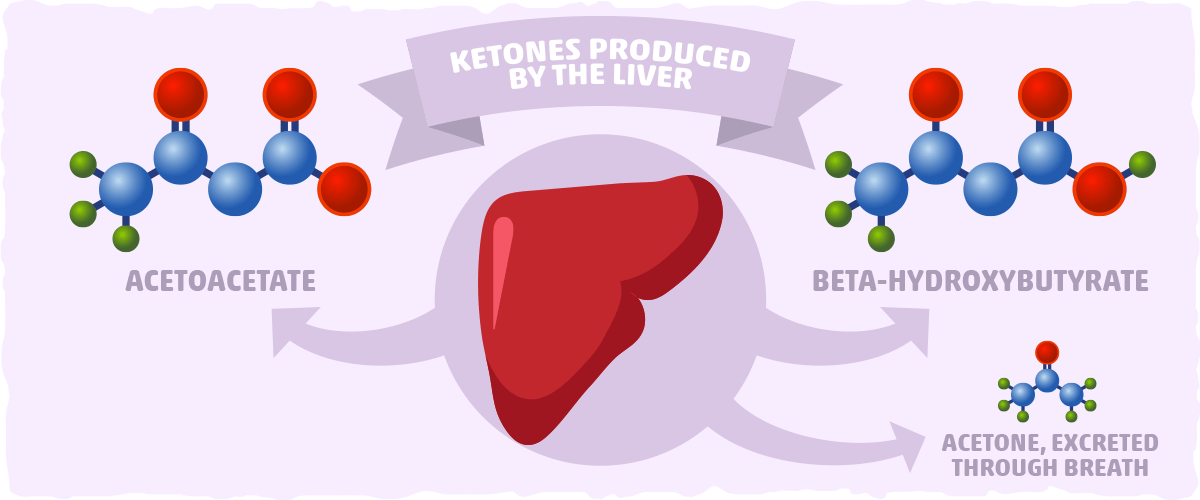
When we eat a carb-rich diet, our primary fuel source is glucose. It can be burned so quickly and is so readily available from the food we eat that many of us default to using glucose for energy.
However, if the diet is not providing enough carbs, such as when someone is fasting or on a ketogenic diet, the body will rely on two metabolic processes to pick up the slack: (1) the cells will burn more fat for fuel and (2) the liver will ramp up a process known as ketogenesis.
During ketogenesis, the liver converts fatty acids (and some amino acids) into ketones. The first one produced is acetoacetate, which is made from two acetyl CoA molecules — energy shuttling compounds of energy metabolism — that are “joined” together.
Once acetoacetate is produced, it will have one of three fates: (1) It’ll be sent off to other cells and used as fuel, (2) it’ll be converted into a more energy-efficient ketone body called BHB and used as energy throughout the body, or (3) it will spontaneously react to create acetone (which is excreted — typically through the breath — and is not used for energy).
In summary, the three ketones that we produce are acetoacetate, BHB, and acetone. The first two are used as an energy alternative to sugar, while acetone is excreted almost immediately. Acetoacetate is the first ketone body produced — and without it, BHB and acetone cannot be formed.
Below, you can see a chart comparing the three types of ketones that are made in the body:
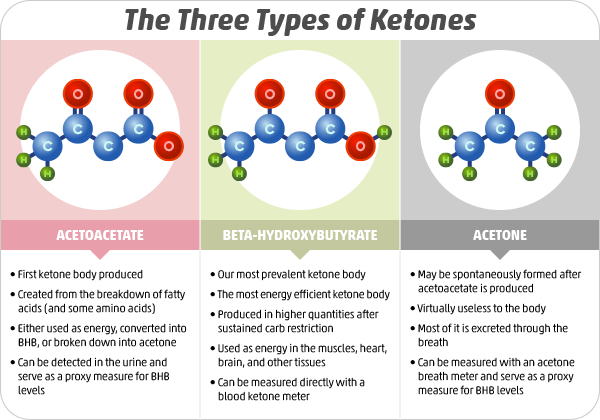
Now you know the basic mechanisms behind ketone production, but one question remains: Why does our body waste precious energy producing ketones if it can just burn fat?
The Purpose of Ketones: Acetoacetate Prolongs Your Life

After digging through the research on ketones (which you can find in this article), one clear purpose of ketogenesis emerges: to create fuel for the brain when sugar is not available.
This is absolutely necessary because almost all of our brain cells cannot use fatty acids for fuel. The process of fat metabolism is simply too slow to keep up with the brains energy needs (and converting protein to sugar by using gluconeogenesis would cause too much muscle wasting), so evolution came up with a better solution — ketones. These small, water-soluble molecules serve as efficient energy shuttles that almost effortlessly travel through the blood and cross the blood-brain barrier. The same cannot be said for fats (except for some medium chain triglycerides).
Once the ketones are in the brain, they act as a quick energy source (similar to sugar) while also being much more efficient than sugar. As a result, the cells accumulate fewer free radicals and reactive oxygen species, protecting the brain from cell damage and cognitive impairment. This is part of the reason why ketones have been found to improve brain health, even in cognitively impaired adults.
The healthiest way to experience these (and the many other) benefits of using ketones for fuel is by following a ketogenic diet. At first, it will be difficult for the body to adapt, but it will eventually start producing and burning more and more ketones — especially BHB.
Acetoacetate and the Ketogenic Diet
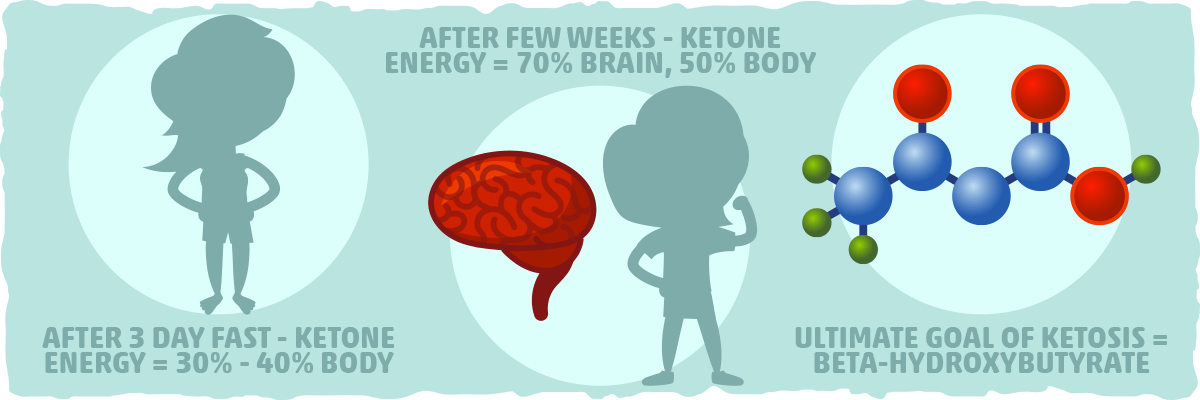
Although acetoacetate serves as an energy producing ketone body, it isn’t the primary ketone that the liver aims to create. As the demand for ketones increases, acetoacetate simply acts a transitional ketone molecule that paves the way for BHB, the most energy efficient ketone, to be produced.
When you first start the ketogenic diet, however, acetoacetate will be created in much higher quantities. At this time, the liver is not ripe enough with ketone producing enzymes and energy substrates to consistently carry out the final step of ketogenesis — the step that produces BHB.
Instead, the final product of ketogenesis, when you first start restricting carbs, is much more likely to be acetoacetate. This is why many first-time keto dieters will notice an unfamiliar odor coming from their urine (because of acetoacetate excretion) or the smell of nail polish remover or overripe fruit on their breath (because of acetone excretion).
Fortunately, as you continue to restrict carbs, your liver will start producing more BHB and regulating ketone levels more efficiently while your other cells improve their ketone burning abilities. Altogether, this means that you will burn more ketones for fuel without excreting so many of them.
To give you a better idea of how long this will take, here are a couple of findings that will put ketone burning into context:
- Ketone bodies naturally supply 2–6% of the body’s energy requirements.
- After a 3-day fast, ketones will typically provide 30–40% of the energy. (Reaching this level of ketone use may take a couple of days longer for keto dieters.)
- After several weeks of keto dieting, ketone bodies can provide up to 70% of the brain’s energy and up to 50% of the energy used for fueling the body’s tissues.
- The ultimate goal of ketogenesis (ketone production) is to create BHB. The longer that carbs are restricted, the more BHB we will produce.
- Being in sustained nutritional ketosis is the best way to burn more BHB for fuel, become keno-adapted, and reap all of the benefits of ketones.
Acetoacetate and Ketosis
Ketosis is one of the primary goals of following a ketogenic diet, and acetoacetate production is the first step to reaching that goal.
Technically, ketosis is achieved when you have blood ketone levels of 0.5 millimoles of BHB per liter (mmol/L). This is considered as “mild ketosis”.
Whether you or in ketosis or not depends mostly on your BHB concentrations — and not acetoacetate levels — because BHB is the most prevalent ketone in the body when you are in ketosis, it can be directly tested by drawing a small amount of blood, and it is the one ketone you want to be producing and using more of.
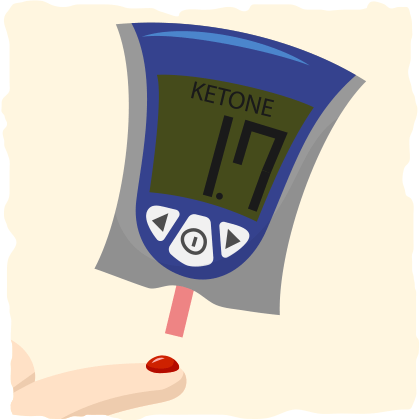
Your blood ketone concentration and your subsequent level of ketosis depends on how many grams of carbs and protein you consumed and how long you have been eating a ketogenic diet. Both carbs and protein consumption can decrease your ketone levels (via stimulating insulin release) — and, once you are eating the right macros, it will take several days for the liver to start pumping out enough BHB for you to technically be in ketosis.
For most people, blood ketone levels will rise above 0.5 mmol/L after eating keto for two days to two weeks. If you are eating what you think is “keto” but you are not in ketosis, then this is technically not a keto diet and macronutrient consumption should be adjusted to stimulate ketone production more effectively. Once you have optimized your keto diet and are in sustained ketosis, you will finally be able to experience the unique benefits of ketosis — benefits that no other diet can consistently provide for you.
Benefits of Ketosis
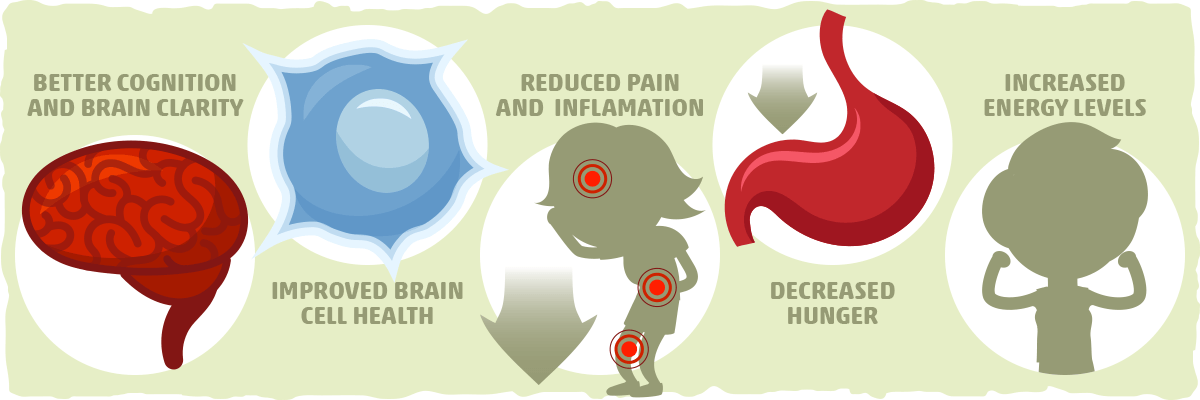
Although the ketogenic diet in itself has a plethora of benefits (that you can read about here), for the purposes of this article let’s focus on what using acetoacetate and BHB does for the body.
Here is a brief overview of the benefits that are directly related to ketosis and ketones:
- Enhanced cognitive function and mental clarity
- Improved brain cell health
- Reduction in pain and inflammation
- Decreased hunger
- Increased energy levels and endurance
These are the known effects that ketosis can have throughout the body. Plus, when you sustain ketosis for more extended periods of time (i.e., several months), you will be able to experience all of these benefits to the fullest.
Researchers are still discovering more and more about ketones and what they do to our cells. However, our current base of knowledge on the topic provides us with plenty of evidence supporting the therapeutic benefits of ketosis for a wide range of people with various goals and conditions — all of which you can read more about here.
Testing for Ketosis with Acetoacetate (and the Other Ketones)
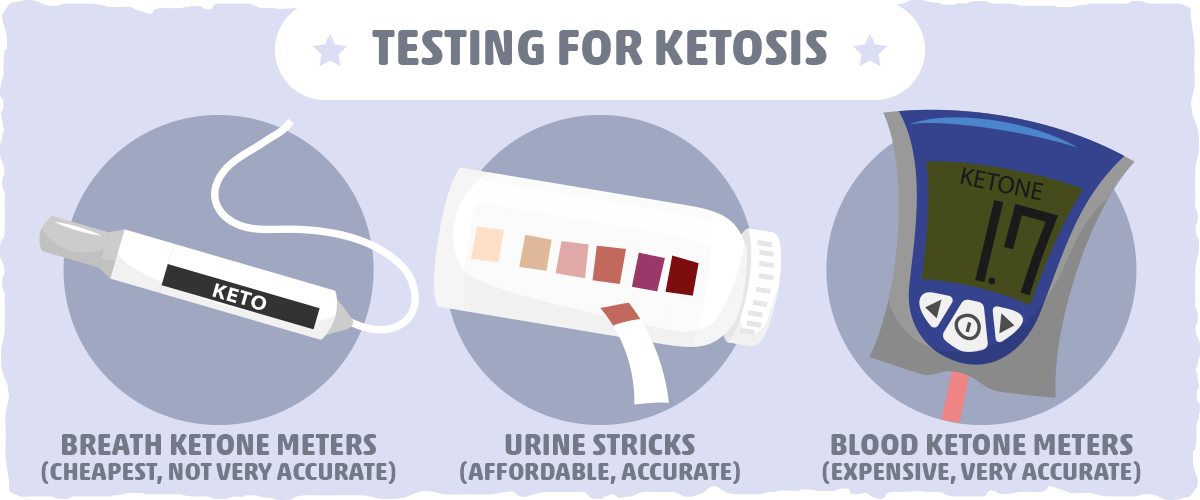
Although you can check for several signs of ketosis to see if you are producing ketones, the most accurate way to determine if you are in ketosis is by measuring your ketone levels. One of the simplest and cheapest ways to do this is by measuring acetoacetate excreted through the urine.
Urine testing for ketosis can be done by peeing on a urine strip, which then changes color to indicate ketone levels. These are very affordable and can usually be purchased online or at your local pharmacy.
Urine test strips tend to be most accurate within the first few days of keto dieting. One study found that after 24 hours of following the keto diet, urinary acetoacetate levels showed a moderate correlation with BHB ketone levels in the blood plasma. The same relationship was found for testing breath acetone levels as well (another method of tracking ketosis).
Unfortunately, both urine test strips and acetone breath meters tend to become less accurate as the person accumulates more time in ketosis. This is because our bodies become more efficient at using and holding onto acetoacetate (keeping it from being excreted) and turning it into BHB as we continue following the keto diet.
To avoid any frustration with breath or urine ketone testing, I recommend using a blood ketone meter that tests BHB levels directly. This is the gold standard for measuring plasma ketones, providing a definitive answer to two crucial questions: Am I in ketosis? If so, is it a mild, moderate, or deep level of ketosis?
Keep in mind, however, that the blood test strips will be expensive if you diligently track your ketone levels. This is why you may want to use urine test strips or an acetone breath meter as soon as you start keto dieting.
Although they aren’t 100% accurate measures for what you want to know, you can use your knowledge of ketones and these testing methods to your advantage.
When testing acetoacetate levels in your urine, for example, simply check to see if you have lower ketone levels in your urine over time. If this occurs as you continue to follow the keto diet, then it is likely that ketone production isn’t actually going down. Instead, this indicates that the body is producing more BHB and using acetoacetate more efficiently.
If you would like to know exactly what level of ketosis you are in, however, it is best to use a blood ketone meter.
On the other hand, if you don’t require precision, all you will need is one of the other testing methods or simply check for the tell-tale signs of ketosis and stick to your keto diet.
Is Acetoacetate Safe?
There are many common misconceptions surrounding ketosis and high ketone levels. Many medical professionals are taught that having elevated acetoacetate levels is harmful and should be avoided because it will lead to a state of metabolic acidosis known as ketoacidosis.
Ketoacidosis, which is commonly called diabetic ketoacidosis, is a dangerous condition that can occur in those with type 1 and type 2 diabetes. When they have an underlying insulin deficiency, either from not making enough or not injecting enough, their body loses the ability to regulate ketone production and blood sugar levels. Over time this can lead to dangerously high levels of blood glucose and blood ketones simultaneously.

The second most common cause of ketoacidosis is binge drinking for a prolonged period of time without consuming calories and carbohydrates. This is known as alcoholic ketoacidosis and results in dangerously high levels of plasma ketones and blood sugar as well.
Ketoacidosis can also occur in people who are under extremely stressful and calorie-restricted conditions. For a closer look at this potentially life-threatening condition, read through our guide to ketoacidosis.
Fortunately, ketoacidosis is not the same as the nutritional ketosis that occurs as a result of keto dieting. In contrast to the causes of ketoacidosis, the keto diet provokes ketone production and ketosis in a healthy way that the body can easily keep under control.
In fact, the combination of the keto diet and ketosis allows us to improve overall health, lose excess weight, and burn fat while maintaining sustained energy and steady blood sugar levels. Plus, it is safe and effective for long-term dieting (for most people).
Cause of Confusion, Not Concern: Acetoacetate vs. Ethyl Acetoacetate
Ethyl acetoacetate is often confused with the acetoacetate ketone body, but only one is naturally made in your body.
Ethyl acetoacetate, also known as ethyl 3-oxobutanoate, has been reported in coffee, passion fruit, and strawberries in minuscule amounts and is used as a flavoring agent in foods.
In its purest form, ethyl acetoacetate is a colorless liquid that can cause adverse health effects if inhaled, placed on the skin, or ingested in large quantities. Fortunately, this is unlikely to occur unless you work in a lab.
In contrast, acetoacetate is produced naturally by your liver and is completely safe when you’re on a ketogenic diet or intermittent fasting.
FAQs: Simple Answers to Complex Ketone Questions
What is acetoacetate? A simple definition for keto dieters
Acetoacetate is the first ketone body produced in the liver while keto dieting. It’s the precursor to beta-hydroxybutyrate (BHB), a vital energy source when you’re in ketosis.
What is the function of acetoacetate?
Acetoacetate is made by the liver to act as an alternative energy source and be converted into the most energy-efficient ketone, beta-hydroxybutyrate (BHB).
What does high acetoacetate mean?
If you are fasting or following a ketogenic diet, high acetoacetate levels in blood plasma or urine are a normal physiological occurrence.
However, for those who are not on a well-formulated keto diet or fasting plan, high levels of acetoacetate may result from:
- uncontrolled diabetes
- alcoholism
- starvation
- excessive physiological stress
- glycogen storage diseases
In this case, you must seek proper medical care immediately.
Key Takeaways — What You Need to Know About Acetoacetate
There are three main types of ketone bodies that can be detected in the bloodstream during ketosis:
- Acetoacetate
- Beta-hydroxybutyrate (BHB)
- Acetone
Acetoacetate is the first ketone body that your liver produces. During the first few days of keto dieting (or fasting), you are much more likely to create and excrete more acetoacetate and acetone (a spontaneously formed ketone that is virtually useless). To refresh you on this, you can review the graphic below:
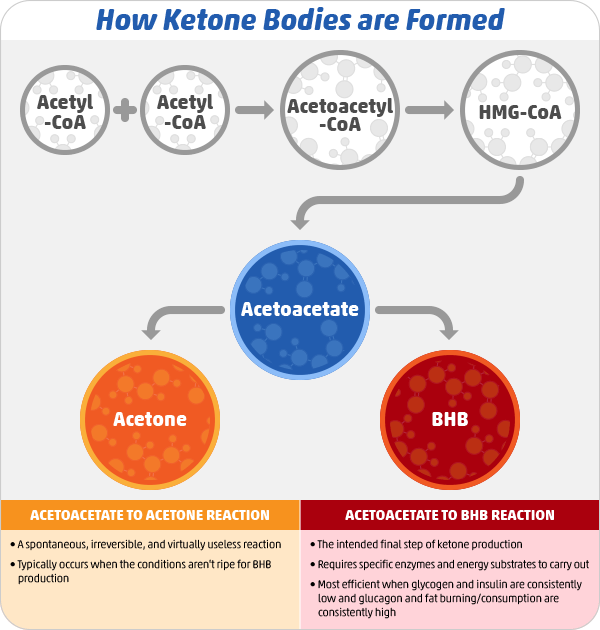
After carbohydrates are restricted consistently for several days, the body will excrete less acetoacetate and produce much more of the most energy efficient ketone body: BHB. As a result, most of your cells become ketone burning machines, and you experience the many benefits of ketosis.
To test if you are on the right track, you can use indirect ketosis measurements like acetone breath meters or acetoacetate-detecting urine sticks, but they will become less and less accurate as your body adapts to the keto diet. The more precise ketone tracking method is a blood ketone meter that tracks your blood BHB levels directly.
Whether you decide to use these keto tracking methods or not, it is important to remember that you must follow the ketogenic diet correctly to increase ketone levels and reap all of the benefits of sustained ketosis. To figure out what the right keto diet is for you, I recommend reading through our comprehensive beginner’s guide to the keto diet and using our keto calculator.
Sources:
- What Are Ketones? Everything You Need to Know — Ruled.me
- This is How We Burn Ketones for Energy — Chris Masterjohn PhD
- Regulation of Ketone Body Metabolism and the Role of PPARα — NCBI
- Do ketogenic diets really suppress appetite? A systematic review and meta-analysis. — NCBI
- Ketone Bodies in Epilepsy — NCBI
- Malonyl-CoA: the regulator of fatty acid synthesis and oxidation — NCBI
- Ketosis as a treatment for multiple metabolic and neurodegenerative pathologies — Journal of Translational Science
- Effect of weight loss and ketosis on postprandial cholecystokinin and free fatty acid concentrations. — NCBI
- Beyond weight loss: a review of the therapeutic uses of very-low-carbohydrate (ketogenic) diets. — NCBI
- Breath acetone is a reliable indicator of ketosis in adults consuming ketogenic meals — The American Journal of Clinical Nutrition
- Ketone body metabolism — DiaPedia
